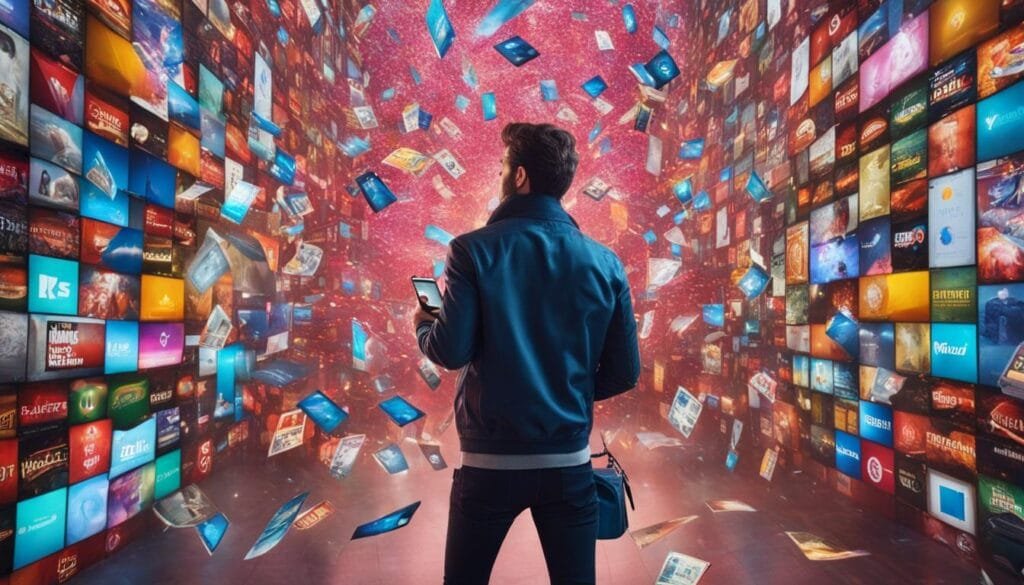Are you guilty of making impulsive purchases after scrolling through social media? You’re not alone. According to a recent survey, almost half of social media users have succumbed to impulse buying, with regrets following closely behind. It’s no surprise, given the ease and convenience of online shopping and the enticing content that bombards our feeds.
So, what triggers this impulsive behavior and how can we regain control over our spending habits? In this article, we delve into the world of social media and impulse buying, exploring the factors that influence our decisions and providing strategies to resist the temptation. It’s time to take charge of our financial well-being and make conscious choices when it comes to online shopping.
Key Takeaways:
- Impulse buying on social media is a widespread phenomenon, with many users regretting their snap decisions.
- Millennials and Gen Z are the biggest spenders when it comes to impulse purchases on social media.
- Social media algorithms play a significant role in influencing our impulse buying behavior by showing us personalized content.
- Emotions, past experiences, sales and deals, and the love of shopping all contribute to impulse buying on social media.
- By employing strategies such as delayed purchasing, budgeting, inventory assessment, wish lists, and curated screen time, we can resist the urge to make impulsive purchases and regain control over our finances.
The Impact of Social Media Algorithms
Social media algorithms play a significant role in influencing impulse buying behavior. These algorithms tailor content to individual users, showing them products and items that they are likely to be interested in. This personalization can lead to impulsive purchases as users are exposed to appealing products and targeted ads.
Studies have found that tailored content on social media platforms can evoke buying desires and prompt impulse purchases. According to a study conducted by the Journal of Consumer Research, personalized advertising can significantly increase the likelihood of impulse buying. By presenting users with products that align with their preferences, past purchases, and browsing history, social media algorithms create a sense of urgency and desire, pushing individuals to make impulsive buying decisions. {“Personalization is the driving force behind social media algorithms shaping impulse buying behavior.”}
Additionally, social media algorithms prioritize content that generates high engagement rates, creating a competitive environment where users feel the need to keep up with trends and make purchases to stay relevant. This constant exposure to new products and trends can further fuel impulsive buying behavior. As a result, individuals may find themselves succumbing to the temptation of making impulse purchases, driven by the fear of missing out and the desire to fit in.
| Impulse Buying Triggers | Effect |
|---|---|
| Personalized content | Elicits desire and prompts impulse purchases |
| Competitive environment | Fosters fear of missing out and promotes impulsive buying |
| Urgency and scarcity tactics | Creates a sense of urgency and prompts impulsive buying |
The Influence of Urgency and Scarcity Tactics
Scarcity is a powerful psychological trigger that can lead to impulse buying. Limited-time offers, flash sales, and one-time deals create a sense of urgency and scarcity, making individuals feel compelled to make immediate purchases. By emphasizing the fear of missing out, social media algorithms capitalize on this fear and drive impulsive buying behavior. {“Urgency and scarcity tactics are commonly used by social media algorithms to prompt impulse purchases.”}
It is crucial for individuals to be aware of the influence that social media algorithms have on their spending behavior. By understanding the tactics employed by algorithms to elicit impulsive buying, individuals can take steps to resist the impulse and make more conscious purchasing decisions. In the next section, we will explore the factors behind impulse buying on social media and strategies to resist this behavior.
Understanding the Factors behind Impulse Buying
Impulse buying on social media is driven by various factors that tap into consumers’ emotions, past experiences, and love of shopping. These factors can significantly influence purchasing decisions and contribute to impulsive buying behavior.
- Emotions: Emotions play a significant role in impulse buying. Many individuals turn to retail therapy to cope with personal challenges or seek comfort in making purchases. Companies strategically use emotional appeals in their advertisements to trigger impulsive buying behaviors.
- Past experiences: Past experiences, such as upbringing and lack of financial education, can shape impulsive buying behavior. Individuals who grew up in households where shopping was seen as a form of self-expression or emotional release may be more prone to making unplanned purchases.
- Sales and deals: The allure of sales and deals can lead to impulsive purchases. Limited-time offers or perceived savings can create a sense of urgency, prompting individuals to make impulsive buying decisions to take advantage of the discounts.
- Love of shopping: Some individuals simply enjoy the act of shopping itself. The thrill of discovering new products, exploring different options, and making purchases releases dopamine in the brain, reinforcing impulsive buying behavior.
Understanding these factors can help individuals become more aware of their own impulsive buying tendencies. By recognizing the emotional triggers, reflecting on past experiences, and being mindful of the influence of sales and the love of shopping, individuals can take steps to gain control over their impulse buying behavior.

It is important to note that while these factors contribute to impulse buying, they are not the sole determinants. Each individual’s impulse buying behavior is unique, influenced by a combination of personal, social, and situational factors. By gaining a deeper understanding of these factors, individuals can develop strategies to resist the urge to make impulsive purchases and make more informed buying decisions that align with their financial goals and priorities.
Strategies to Resist Impulse Buying on Social Media
Impulse buying on social media platforms can be a challenge to overcome, but with the right strategies, individuals can resist the urge to make impulsive purchases and regain control over their spending habits. Here are some effective techniques to help you resist impulse buying:
- Delayed Purchasing: When you come across something tempting on social media, make a conscious effort to delay your purchase decision. Give yourself a day or two to think about whether you truly need or want the item. This delay can help you avoid snap decisions and impulsive purchases.
- Budgeting: Creating and sticking to a budget is essential for managing your finances and curbing impulse buying. Plan your spending and allocate a specific amount for discretionary purchases. By prioritizing your needs over wants, you can make more conscious purchasing decisions.
- Inventory Assessment: Before making a new purchase, take a moment to assess your current inventory of belongings. Evaluate whether you actually need the item or if it will simply add clutter to your life. Sometimes, realizing you already have similar items can help you resist the urge to buy unnecessarily.
- Wish Lists: Utilize wish lists or bookmarking features on e-commerce platforms to keep track of products you’re interested in. Instead of making impulsive purchases, add items to your wish list and revisit them after some time. You may find that your desire for certain items diminishes over time, helping you make more intentional purchasing decisions.

Curated Screen Time: Being mindful of the content you consume on social media can significantly reduce exposure to impulse-driven advertisements and influencer promotions. Take control of your screen time by unfollowing or muting accounts that promote excessive consumerism, and instead follow accounts that inspire you to prioritize financial well-being and conscious living.
By implementing these strategies and being mindful of your impulse buying triggers, you can resist the allure of impulsive purchases on social media and make more intentional choices that align with your long-term financial goals.
Conclusion
Impulse buying on social media can have a significant impact on individuals’ spending habits and financial well-being. The influence of social media algorithms and personalized content cannot be underestimated, as they play a key role in evoking desires and prompting impulsive purchases.
However, there are strategies that can help individuals regain control over their spending behavior and make more conscious purchasing decisions. By implementing these strategies, individuals can resist the urge to make impulse purchases and prioritize their financial discipline.
One important strategy is delaying purchases. Taking a day or two to think about a potential purchase can help individuals avoid making snap decisions and give them time to evaluate their true needs versus wants.
Creating and sticking to a budget is another crucial step in resisting impulse buying. By planning their spending, individuals can prioritize their needs and make mindful decisions about how their money is allocated.
In addition, assessing one’s current inventory of belongings can help individuals realize that they may not actually need a new purchase. Keeping wish lists to track desired items and comparing options before making a purchase decision can also contribute to more conscious buying habits. Lastly, curating screen time and being mindful of the content consumed on social media can reduce exposure to impulse-driven advertisements and influencer promotions.
By implementing these strategies and prioritizing financial discipline, individuals can regain control over their spending behavior and make more conscious purchasing decisions, ultimately achieving their long-term financial goals.
FAQ
How many social media users make impulse purchases?
Nearly half of social media users have made an impulse purchase after seeing something online.
How much do impulse buyers spend on average?
On average, impulse buyers spend $754 on items they see on social media platforms.
How much money do Americans splurge on impulse purchases in a year?
Americans splurge a total of $71 billion on impulse purchases in the last 12 months.
Which age groups are the biggest spenders in impulse buying on social media?
Millennials and Gen Z are the biggest spenders in this category, with average impulse purchases of $1,016 and $844 respectively.
How do social media algorithms influence impulse buying behavior?
Social media algorithms tailor content to individual users, showing them products and items they are likely to be interested in, which can lead to impulsive purchases.
What factors contribute to impulse buying on social media?
Emotions, past experiences, sales and deals, and the love of shopping itself contribute to impulse buying on social media.
What strategies can help resist impulse buying on social media?
Strategies such as delaying purchases, creating budgets, assessing inventories, making wish lists, and curating screen time can help resist impulse buying on social media.
How Can I Avoid Overspending on Social Media Advertising?
When it comes to budgeting for social media advertising, there are a few strategies you can implement to avoid overspending. Start by setting clear objectives and defining your target audience. Evaluate the best platforms for your business and monitor the performance of your campaigns regularly. Don’t forget to establish a maximum budget and stick to it, while also considering alternative cost-effective advertising methods.

